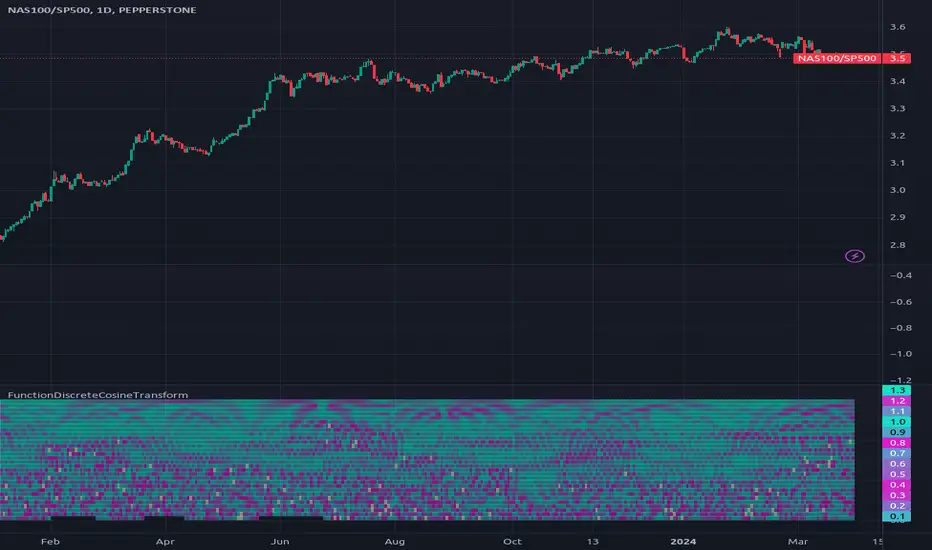PINE LIBRARY
FunctionDiscreteCosineTransform

Library "FunctionDiscreteCosineTransform"
Discrete Cosine Transform (DCT)
The Discrete Cosine Transform (DCT) is a mathematical algorithm that converts a series of samples of a signal, typically in the time domain, into another domain called the frequency or spectral domain. It's commonly used for data compression and image/video coding applications such as JPEG and MPEG standards.
The DCT works by multiplying the input sequence with specific cosine functions that are pre-defined and then summing up these products to obtain a new series of values, which represent the frequency components of the original signal. The main advantage of the DCT over other transforms like Fourier Transform is its ability to handle non-stationary signals (i.e., signals with varying statistical properties) more effectively due to its localized basis functions.
In simple terms, the DCT can be thought of as a way to break down an image or video into different frequency components and then compress them without losing too much information. This compression technique is essential for efficient transmission and storage of digital media files over the internet or on devices with limited memory capacity.
~Mixtral4x7b
___
Reference:
lcamtuf.substack.com/p/not-so-fast-mr-fourier
dct(data, len)
Discrete Cosine Transform.
Parameters:
data (array<float>): Data source.
len (int): Length of the sampling window.
Returns: List with frequency domain transformed information.
dct(data, len)
Discrete Cosine Transform.
Parameters:
data (float): Data source.
len (int): Length of the sampling window.
Returns: List with frequency domain transformed information.
idct(data, len)
Inverse Discrete Cosine Transform.
Parameters:
data (array<float>): Data source.
len (int): Length of the sampling window.
Returns: List with time domain transformed information.
idct(data, len)
Inverse Discrete Cosine Transform.
Parameters:
data (float): Data source.
len (int): Length of the sampling window.
Returns: List with time domain transformed information.
Discrete Cosine Transform (DCT)
The Discrete Cosine Transform (DCT) is a mathematical algorithm that converts a series of samples of a signal, typically in the time domain, into another domain called the frequency or spectral domain. It's commonly used for data compression and image/video coding applications such as JPEG and MPEG standards.
The DCT works by multiplying the input sequence with specific cosine functions that are pre-defined and then summing up these products to obtain a new series of values, which represent the frequency components of the original signal. The main advantage of the DCT over other transforms like Fourier Transform is its ability to handle non-stationary signals (i.e., signals with varying statistical properties) more effectively due to its localized basis functions.
In simple terms, the DCT can be thought of as a way to break down an image or video into different frequency components and then compress them without losing too much information. This compression technique is essential for efficient transmission and storage of digital media files over the internet or on devices with limited memory capacity.
~Mixtral4x7b
___
Reference:
lcamtuf.substack.com/p/not-so-fast-mr-fourier
dct(data, len)
Discrete Cosine Transform.
Parameters:
data (array<float>): Data source.
len (int): Length of the sampling window.
Returns: List with frequency domain transformed information.
dct(data, len)
Discrete Cosine Transform.
Parameters:
data (float): Data source.
len (int): Length of the sampling window.
Returns: List with frequency domain transformed information.
idct(data, len)
Inverse Discrete Cosine Transform.
Parameters:
data (array<float>): Data source.
len (int): Length of the sampling window.
Returns: List with time domain transformed information.
idct(data, len)
Inverse Discrete Cosine Transform.
Parameters:
data (float): Data source.
len (int): Length of the sampling window.
Returns: List with time domain transformed information.
Pineライブラリ
TradingViewの精神に則り、作者はこのPineコードをオープンソースライブラリとして公開してくれました。コミュニティの他のPineプログラマーが再利用できるようにという配慮です。作者に拍手を!このライブラリは個人利用や他のオープンソースの公開コンテンツで使用できますが、公開物でのコードの再利用はハウスルールに準じる必要があります。
免責事項
この情報および投稿は、TradingViewが提供または推奨する金融、投資、トレード、その他のアドバイスや推奨を意図するものではなく、それらを構成するものでもありません。詳細は利用規約をご覧ください。
Pineライブラリ
TradingViewの精神に則り、作者はこのPineコードをオープンソースライブラリとして公開してくれました。コミュニティの他のPineプログラマーが再利用できるようにという配慮です。作者に拍手を!このライブラリは個人利用や他のオープンソースの公開コンテンツで使用できますが、公開物でのコードの再利用はハウスルールに準じる必要があります。
免責事項
この情報および投稿は、TradingViewが提供または推奨する金融、投資、トレード、その他のアドバイスや推奨を意図するものではなく、それらを構成するものでもありません。詳細は利用規約をご覧ください。